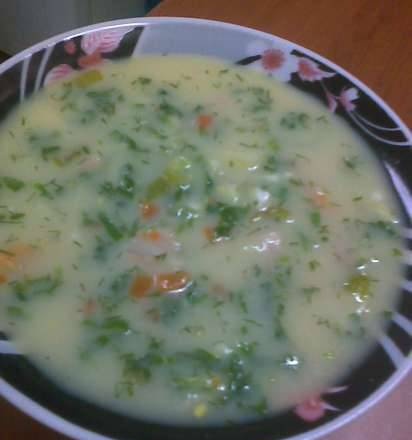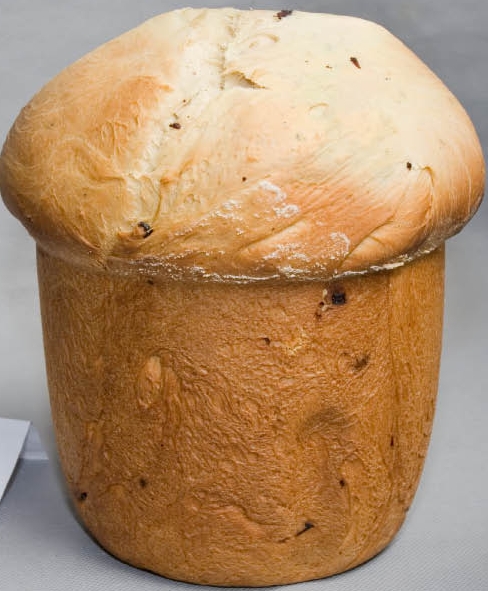 Cooking Easter cake takes a lot of time, but the owners of modern bread makers can enjoy homemade Easter cake without spending any extra time or effort on it.
Cooking Easter cake takes a lot of time, but the owners of modern bread makers can enjoy homemade Easter cake without spending any extra time or effort on it.
The master class was conducted by Olga KUZMINA.
We will tell you in detail how we made the cake during our bread maker test - recipe and appliance provided by Kenwood. In addition, we were offered a special round-shaped bucket.
Easter cake is prepared in a special program for baking sweet bread (most bread makers have it), but many housewives use the main mode (the duration is usually over 3 hours). We did the same, chose 1 program.
The recipe for traditional Easter cake involves the preparation of dough, then the dough, its aging and baking.
In a bread maker, this process is greatly simplified - the dough is immediately kneaded and allowed to stand at an elevated temperature (with kneading set at a certain time to release gas), then the cake is baked.
In order to give the product a real taste of baking, eggs, milk, butter are added to it.
Recipe for 1 kg cake *: milk - 250 g, eggs - 2 pcs, butter - 150 g, wheat flour - 600 g, salt - 1.5 teaspoons, sugar - 80 g, dry yeast - 2.5 teaspoons, raisins, candied fruits - full dispenser ...
The cake is made especially tasty by aromatic additives - orange juice, liqueurs, rum, orange and lemon peel, spices (ground cinnamon, cloves, ginger, star anise, cardamom and others).
I add everything I can to my Easter cakes to make the flavor as vivid as possible.
In addition, nuts, raisins, candied fruits are always put (candied ginger is especially good - a wonderful smell), peanuts, vanilla or vanilla sugar is added (included in the total mass of sugar).
* I'll make a reservation right away that this recipe has a drawback - there is too much yeast, our cake rose so that it touched the lid with its cap and interfered with the normal circulation of hot air. It is better to take less yeast - 1.5-2 teaspoons.
Step 1
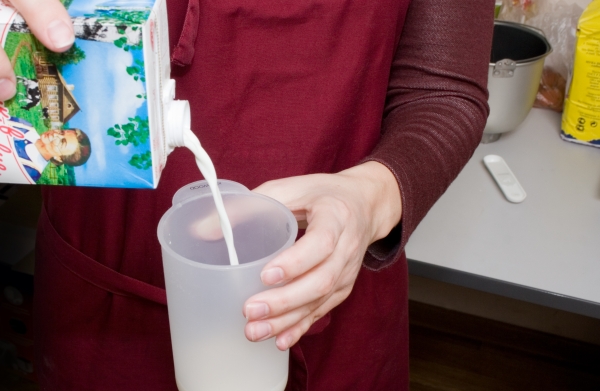
We prepare all the products, take out milk, butter and eggs from the refrigerator, take out a bowl of flour, a strainer, scales, measuring containers. Everything should be at hand so as not to take a single extra step. The bookmark is carried out strictly according to the system proposed by the manufacturer - that is, first all the liquid components, or vice versa - we start with flour (this is stipulated in the instructions). Our option is the first.
We take out the bucket from the stove, put it on the table, put the blade on the pin. Using a measuring cup, we measure the required amount of milk, it is not bad if the milk is at room temperature - this will simplify the inclusion of yeast in the work, although it is not important - heating the stove will equalize the difference in temperatures.
Step 2
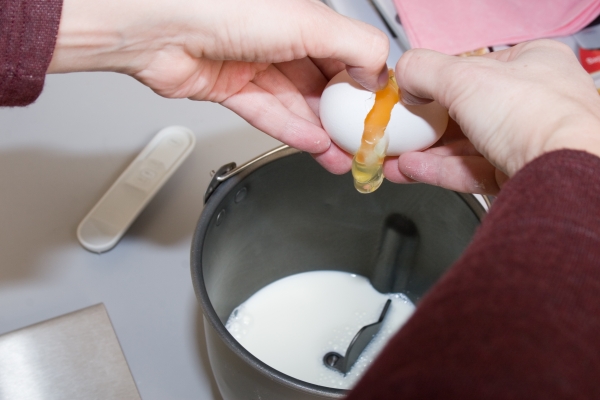
We break the eggs, put them in a bucket. Some manufacturers in the recipe recommend determining the measure of eggs by weight - for the first time, you should probably adhere to these wishes, then you can yourself understand what your recipe suggests (for example, one large egg and one medium).
Step 3
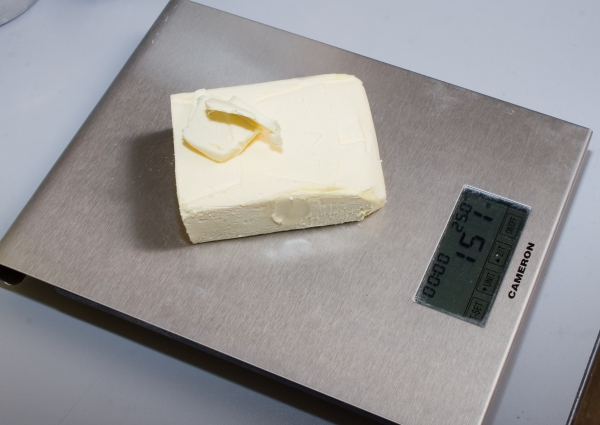
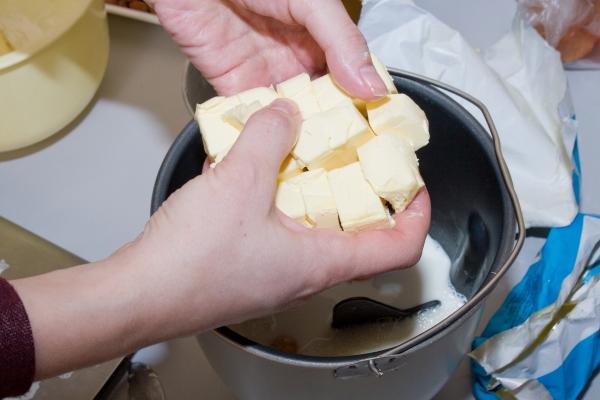
We weigh the butter, cut it into pieces, put it in a bucket.
Step 4

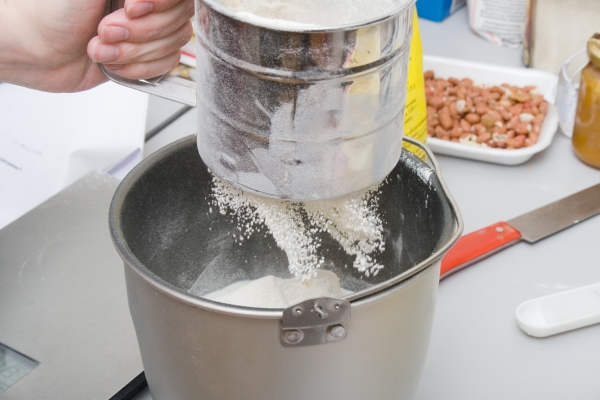
Now we will fill in the flour - it is best to weigh it, and not to determine it using a yardstick - at least for the first time, in order to understand the logic of the recipe. We weigh, and then the flour must be sifted without fail, this will saturate it with oxygen and increase the efficiency of the yeast
Step 5
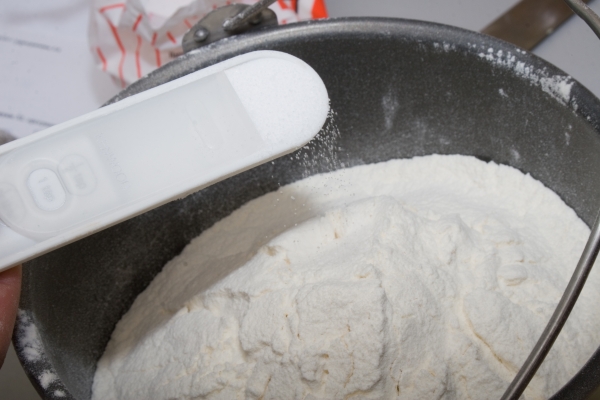
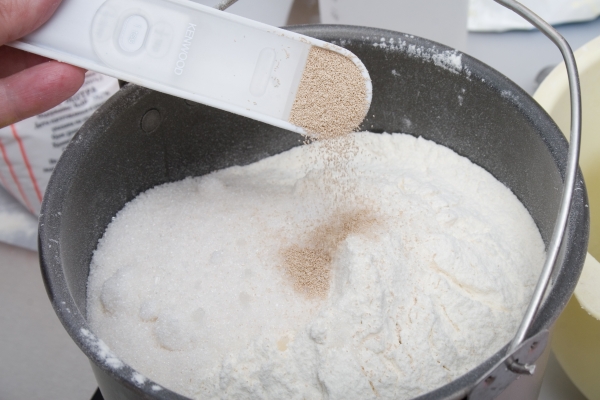
Put salt, sugar - use a measuring spoon. We fill in the components in the corners Now it's time to put the yeast. We measure out the required amount and lower it into the hole made by the palm of the hand in the flour slide. Important: you should not allow the contact of yeast and salt, the latter reduce the efficiency of their work.
Step 6
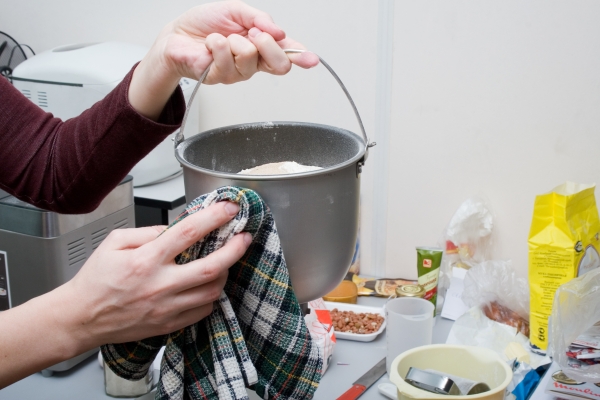
We take a bucket, use a towel to shake off the flour from it and put it on a nest in the chamber of the bread machine.
I try to keep the bookmarking process as short as possible. Therefore, at home I have developed a simple and effective system, which involves a minimum of preparation and almost complete absence of cleaning after work.
I use a special container with a lid - in it I weigh the flour and store the strainer - I specially selected it by size. I never wash the container - it is specialized, it simplifies everything. The scales always hang at my fingertips, the recipe is also on a magnet at eye level, salt and sugar are always on the table. It remains to take from the shelf a jar (or jars, if 2) with flour, a spoon “lives” in each of my containers with flour. In general, after the bucket is put into the device, I need to return everything to its places and wipe the table. Everything takes a maximum of 7 minutes.
Step 7

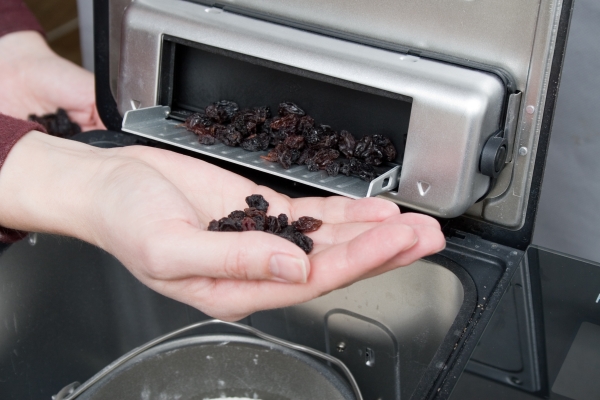
Put raisins, nuts in the dispenser and close it. If your appliance does not have a dispenser, put all additional components in the bucket manually, but not right away! Wait for the sound signal that the oven will sound when mixing. This is done so that the additives do not suffer during the operation of the blade - the raisins can break and the dough will turn bluish. My bread maker is behaving decently, so I put everything I need under the main tab. In any case, spices can be poured along with salt and sugar, and it is better to place them in a corner.
Step 8
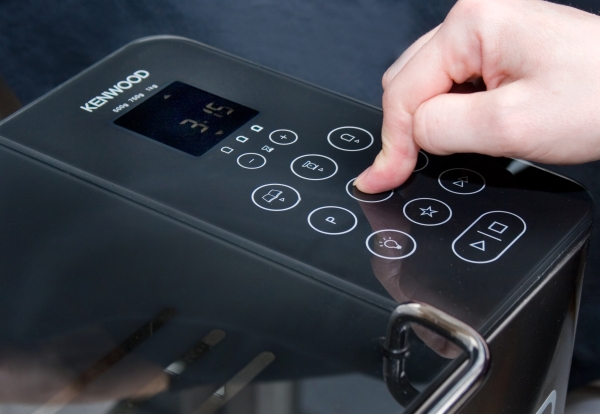
We make the settings - turn on the oven to the network, select the program - in our case 1 (by default), duration 3 hours 15 minutes, then the weight of the loaf is 1 kg, the color of the crust is medium, press the start button. The machine immediately starts working - the blade begins to rotate, and the dough is kneaded. At this stage, some attention is required from the hostess to the process. After 10 minutes, look into the device - it is already clear how well the proportions of the dough have developed. It should look like a bun - that is, a round, strong, non-sticky lump of dough that moves freely after the blade. If the dough is watery, add flour and do this until the result is satisfactory. Feel free to touch the dough, you will quickly understand what and how, if you feel that it is a product of your hands!
Flour is the most important component of both bread and kulich, its amount indicated in the recipe, unfortunately, cannot be called final. Since the moisture content of flour is highly dependent on storage conditions. For example, my favorite bread recipe always involves adding 1 tbsp. flour in winter (with the heating on) and up to 3 in summer. Therefore, you should always focus on the kolobok - the correct kolobok is the key to success.

In this photo, the gingerbread man seems to be good, but a bit damp, so I add flour 2 times, a teaspoon each.
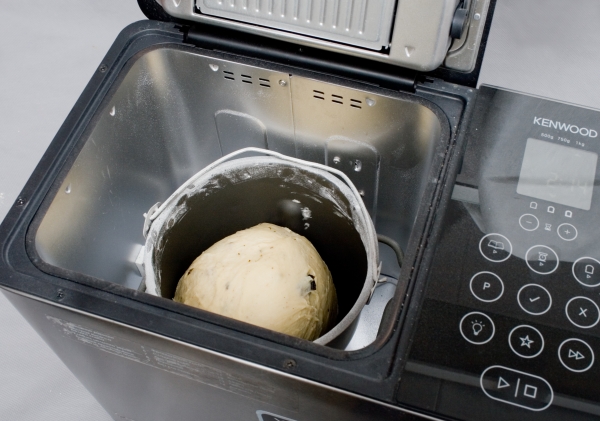
But now in the photo it seems that the gingerbread man has puffed up, but in fact it has become less wet and wrapped around the blade - it looks more compact. The mass of the kolobok has hardly changed - only by a spoonful of flour that I added. Take a look - the bun has become perfect!
Now, when the dough is kneaded and the bun suits us, my active participation in the process ends for a while.
Meanwhile, the automation is constantly working in the bread maker. Now the temperature in the chamber is slightly increased so that the gluten of the dough begins to actively stand out, uniform kneading takes place and, of course, so that the yeast wakes up.
Meanwhile, the automation is constantly working in the bread maker. The temperature in the chamber rises slightly so that flour gluten begins to actively release. The dough was kneaded evenly and, of course, so that the yeast woke up and worked at full power.
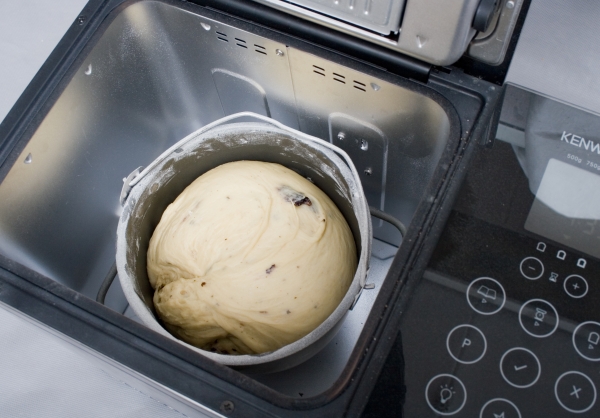
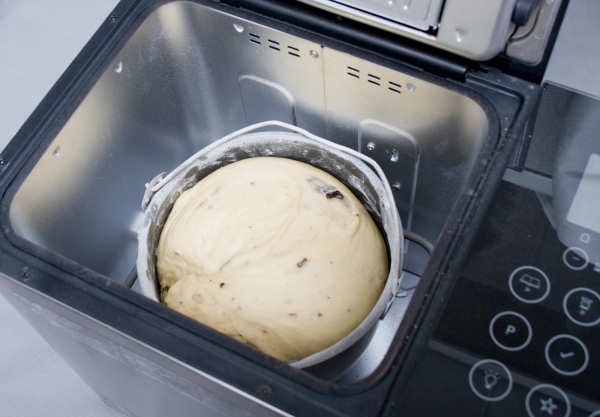


When the kneading is completed, the process of standing the dough begins, it consists of three stages with two kneading. Our photos show how the appearance of the future Easter cake changes during this time.
Step 9
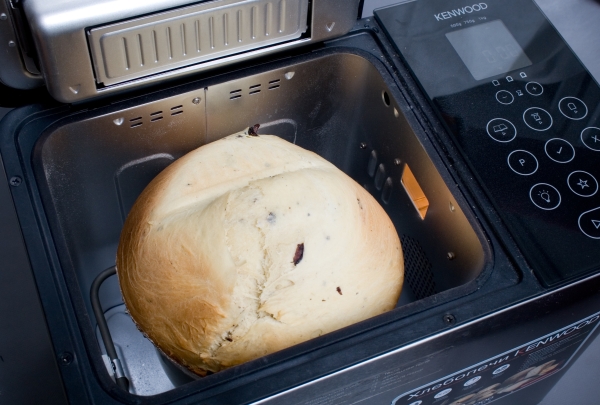
The last step in the program is baking. If you want to get some special crust, you need to look into the stove about 1 hour before the end of the cycle.You can anoint the top of the kolobok with butter (for simple bread with vegetable or vegetable mixed with water) - it will be more ruddy and crisp, use a hard brush for this. You can put chopped or whole nuts, seeds on top (it is better to do this over butter) (I put a little oil in a bowl, sprinkle with water and fill in the seeds, spread with a brush). You can make decorative cuts, such as a cross to a cross, to give the hat the desired shape. As an option, lay out a sign or letter from nuts or raisins (a cross for Easter, if the cake is not glazed, the first letter of the baby's name).

The signal sounds - it's time to take the cake out of the oven. For this, it is always worth using gloves so as not to burn yourself. We take by the handle, take out the bucket. We have order on the table and there is a prepared grid. Shake out the loaf, put on the wire rack and let cool for at least 30 minutes.

The cake is ready! Easter can be decorated with glaze, pour over chocolate, make the necessary inscriptions. Homemade Easter cake is a wonderful thing, there is a minimum of hassle, you can treat guests, feed the children with afternoon tea (my mother constantly bakes Easter cakes when she is given a bunch of grandchildren for the summer), pamper yourself and generally be considered a good housewife who is capable of small culinary achievements.
A source: Buy magazine Household appliances




